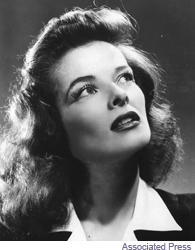For more than six decades, Katharine Hepburn mesmerized audiences with her regal accent, classic beauty and exceptional acting. Her fiercely independent, unconventional persona and boundless zest for life made her one of the iconic actresses of the 20th century.
Katharine Hepburn’s Early Days
Katharine Houghton Hepburn was born in Hartford, Connecticut, on May 12, 1907, the second of six children. Hepburn enjoyed a rather unconventional upbringing in the small coastal town of Old Saybrook. Her father, Tom, was a doctor, while her mother, also named Katharine, was president of the Connecticut Women’s Suffrage Association.
As Anne Edwards notes in “A Remarkable Woman,” her 1985 biography of Hepburn, “Kathy sat in the parlor and listened to…women of radical ideas—in ardent discussions on venereal disease, prostitution and the use of contraceptives, as well as heated political debates and medical specifics on Dr. Hepburn’s cases.”
In a 1987 interview with The New York Times, Hepburn said, “I was brought up to feel as though women were just as good as men—it never occurred to me that I was an inferior sex. I was a different sex.”
Sources in this Story
- The Kennedy Center: Katharine Hepburn
- Adherents.com: The Religious Affiliation of Actress Katharine Hepburn
- The New York Times: Katharine Hepburn Takes the Movies’ Measure
- Entertainment Weekly: Katharine Hepburn
- PR Newswire: AFI Recognizes the 50 Greatest American Screen Legends
- The New York Times: Katharine Hepburn, Spirited Actress, Dies at 96
Hepburn’s Notable Accomplishments
Katharine entered Bryn Mawr College in 1924. After graduation, she acted in stage productions. She signed a contract with RKO Pictures after it accepted her demand for a weekly salary of $1,500—a princely sum at the time.
Hepburn debuted on the big screen with 1932’s “A Bill of Divorcement,” and quickly made a name for herself, winning an Academy Award for Best Actress for her 1933 portrayal of aspiring actress Eva Lovelace in “Morning Glory.”
Despite a string of notable performances, including Jo in “Little Women” (1933), the Oscar-nominated title role in “Alice Adams” (1935) and an eccentric heiress in “Bringing Up Baby” (1938), she also appeared in several flops. Industry insiders and audiences were put off by her refusal to dress glamorously, sit for interviews or provide autographs.
In 1938, Hepburn was labeled “box office poison” by a poll of film exhibitors. But she won back the public by playing Tracy Lord in the 1940 box-office hit “The Philadelphia Story”; it was a role that had been written especially for her.
Hepburn met Spencer Tracy when they filmed “Woman of the Year” (1942). Her chemistry both on and off the screen with the already married actor blossomed into a love affair that would last until his death in 1967. Together, the couple would make nine movies, including “Guess Who’s Coming to Dinner” (1967), which earned Hepburn her second Best Actress Oscar. She picked up another the following year for her role as Eleanor of Aquitaine in “The Lion in Winter.”
Most of the final years of her acting career were spent on television, receiving four Emmy nominations and a win for outstanding lead actress in “Love Among the Ruins” (1975). Hepburn’s last major film performance was in 1981, when she appeared with Henry Fonda in “On Golden Pond.” Both actors picked up Oscars for their performances; it was Hepburn’s fourth.
The Woman and Her Work
- “Me: Stories of My Life” by Katharine Hepburn
- “Katharine Hepburn Collection (Morning Glory / Undercurrent / Sylvia Scarlett / Without Love / Dragon Seed / The Corn Is Green)”
- “TCM Greatest Classic Films Collection: Romantic Comedies (Adam’s Rib / Woman of the Year / The Philadelphia Story / Bringing Up Baby)”
- “Guess Who’s Coming to Dinner”
The Rest of the Story
Accolades continued to follow Hepburn into her later years. In 1999, the American Film Institute gave Hepburn the top spot in their ranking of the 25 greatest female “American screen legends.”
As she aged, Hepburn developed some health problems, but always managed to bounce back. According to her New York Times obituary, “Although her head shook visibly in television interviews from the 1980’s on, she vehemently denied the rumor that she had Parkinson’s disease, saying she had inherited her shaking head from her grandfather Hepburn.”
Hepburn spent the last years of her life out of the public eye. She died on June 29, 2003, at her home in Old Saybrook. She was 96 years old.











